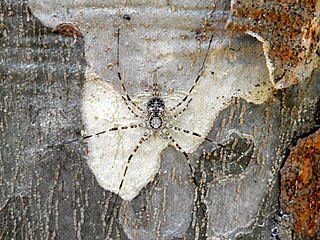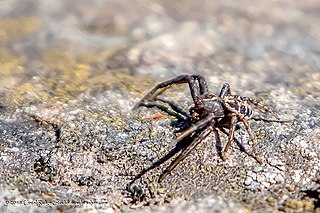
Wolf spiders are members of the family Lycosidae, named for their robust and agile hunting skills and excellent eyesight. They live mostly in solitude, hunt alone, and usually do not spin webs. Some are opportunistic hunters, pouncing upon prey as they find it or chasing it over short distances; others wait for passing prey in or near the mouth of a burrow. Wolf spiders resemble nursery web spiders, but wolf spiders carry their egg sacs by attaching them to their spinnerets, while the Pisauridae carry their egg sacs with their chelicerae and pedipalps. Two of the wolf spider's eight eyes are large and prominent; this distinguishes them from nursery web spiders, whose eyes are all of roughly equal size. This can also help distinguish them from the similar-looking grass spiders.

Huntsman spiders, members of the family Sparassidae, catch their prey by hunting rather than in webs. They are also called giant crab spiders because of their size and appearance. Larger species sometimes are referred to as wood spiders, because of their preference for woody places. In southern Africa the genus Palystes are known as rain spiders or lizard-eating spiders. Commonly, they are confused with baboon spiders from the Mygalomorphae infraorder, which are not closely related.

The Pholcidae are a family of araneomorph spiders. The family contains more than 1,800 individual species of pholcids, including those commonly known as cellar spider, daddy long-legs spider, carpenter spider, daddy long-legger, vibrating spider, gyrating spider, long daddy, skull spider, and angel spider. The family, first described by Carl Ludwig Koch in 1850, is divided into 94 genera.

Velvet spiders are a small group of spiders almost entirely limited to the Old World, with the exception of one species known from Brazil. In Europe, some are commonly called the ladybird spiders.

Rabidosa is a genus of spiders described by Roewer (1960). The family is Lycosidae. It contains the following species:

Rabidosa hentzi is a small species of wolf spider found in North America. Most identified specimens were found in Florida, though some have been found in Georgia and Louisiana. Its color is like that of Rabidosa carrana or Rabidosa rabida, but it is distinguished from other Rabidosa species by its paler color and distinct striped pattern on its back. The cephalothorax is a pale brown-yellow color. Between these is a narrower bright yellow to white streak that extends past the eyes. The sternum and abdomen are both pale, though the upper sides are streaked and spotted with brown markings. The eyes are on a black band that extends back, fading into the pale brown. The spermathecae are round and the palea of the pedipalp has a sclerotized cap. Males and females have a similar face and chelicera, though that of males is usually lighter brown. Males will generally have fewer lateral brown markings on the abdomen than females. In the field, it can be distinguished from similar looking species by the thin yellow stripe on its back. Though usually a ground-dweller, due to scopula hairs on the tarsi and metatarsi, it can sometimes climb into shrubs and bushes. It is the only wolf spider that climbs up into the higher vegetation in open woodland.

Alireza Zamani is an Iranian arachnologist and taxonomist.
Rabidosa santrita is a species of wolf spider in the family Lycosidae. It is found in the United States.

Neotama mexicana, also known as the long-spinneret spider or Mexican two-tailed spider, is a species of tree trunk spider in the family Hersiliidae. It is found in a range from the United States to Peru and Guyana.
Habronattus forticulus is a species of jumping spider in the family Salticidae. It is found in the United States and Mexico.
Xysticus discursans is a species of crab spider in the family Thomisidae. It is found in North America.

Xysticus emertoni, or Emerton's crab spider, is a species of crab spider in the family Thomisidae. It is found in the United States, Canada, Slovakia, Russia, and a range from Central Asia to China.

Pirata piraticus is a species of wolf spider in the family Lycosidae. It is found in North America, Europe, Turkey, Caucasus, a range from Russia, Central Asia, China, and Japan.

Habronattus tranquillus is a species of jumping spider in the family Salticidae. It is found in the United States and Mexico.
Phrurotimpus borealis is a species of true spider in the family Phrurolithidae. It is found in North America.
Diplocentria bidentata is a species of dwarf spider in the family Linyphiidae. It is found in North America, Europe, a range from Russia, and China.
Nodocion floridanus is a species of ground spider in the family Gnaphosidae. It is found in the United States and Mexico.

Aptostichus atomarius, the San Bernardino hills trapdoor spider, is a species of wafer-lid trapdoor spider in the family Euctenizidae. It is found in the United States.

Kaestneria pullata is a species of sheetweb spider in the family Linyphiidae. It is found in North America, Europe, a range from Russia, China, Mongolia, and Japan.

Pholcus manueli, known generally as the cellar spider or daddy longlegs, is a species of cellar spider in the family Pholcidae. It is found in Russia, Turkmenistan, China, Korea, Japan, and the United States.













